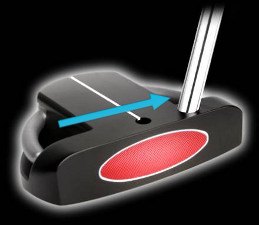
Heel-Shafted Putters
A heel-shafted putter is a type of golf club used specifically for putting. It is called “heel-shafted” due to the placement of the shaft in relation to the clubhead. In this design, the shaft enters the clubhead at the heel, as opposed to the center or the toe of the clubhead. Heel-shafted putters have their own set of characteristics and advantages that make them popular among golfers.
Let's take a closer look at some key points about heel-shafted putters:
- Alignment: Heel-shafted putters are known for their alignment benefits. The clubhead's design helps golfers align their putting strokes and aim accurately. The shaft's placement toward the heel allows the golfer to see the clubface more clearly, which helps in aligning the putter with the target line.
- Moment of Inertia (MOI): The MOI of a putter refers to its resistance to twisting upon impact. Heel-shafted putters generally have a higher MOI compared to other types of putters. The increased MOI helps in reducing the twisting of the clubhead during off-center hits, resulting in more consistent distance control and accuracy.
- Sweet Spot: The sweet spot on a putter is the center point of the clubface that produces the optimal transfer of energy to the golf ball. Heel-shafted putters tend to have a sweet spot located closer to the heel. This placement influences the ideal impact point of the ball on the clubface and promotes a slight arc in the putting stroke.
- Stroke Type: Heel-shafted putters are often favored by players with a slight arc in their putting stroke. The club's design works in harmony with this stroke type, allowing the golfer to maintain a consistent path during the stroke. For golfers with a straight back and through stroke, other types of putters, such as face-balanced putters, might be more suitable.
- Toe Hang: Toe hang refers to how much the toe of the putter hangs down when the club is balanced on a finger. Heel-shafted putters typically have a moderate toe hang. This characteristic affects the swing feel and can be influenced by personal preference.
Heel-shafted putters are available in various styles, including blade putters and mallet putters. Blade putters have a traditional, compact design with a thin clubhead, while mallet putters have a larger and more forgiving clubhead with added weighting. Both types can be heel-shafted, providing golfers with options based on their preferences and playing style.
Ultimately, choosing a putter, whether it's heel-shafted or not, depends on factors like personal preference, stroke type, and feel. Trying out different putters and getting fitted by a professional can help golfers determine the best style and design for their game.





